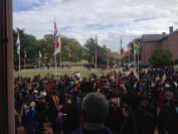
Mark Matel (to the far left) with community activists in Boston.
Thanks to a Facebook post by my (awesome) former student, Elbert Whitfield, I just discovered an article titled Enterprise Rose Fellowship Redefines Community Design at NeighborWorks Organizations, which features former student Mark Matel.
I’ve worked with many extraordinary students at Hampton University, like Elbert and Mark.
Today, I’m boasting of Mark Paulo Ramos Matel’ success. I had the honor of teaching Mark in architectural design studios, study abroad, and environmental sustainability courses while he was working toward his Master of Architecture degree at HU.

Mark Matel (right) with fellow student Leon Peters presenting a second year design project at Hamtpon University.
Mark was an ideal candidate for the Enterprise Rose Fellowship, which the article explains is “a highly competitive and innovative program that places some of the nation’s finest early career architects in underserved communities across the country to team up with community development host organizations.”
Mark is intrinsically motivated to succeed, to help people, and to spearhead new initiatives. His energy level, work ethic, creativity, self-direction, and ability to collaborate effectively were unparalleled among the students I have encountered in my 15 years of university-level teaching.
Mark was a major player in the formation of our department’s Studio Culture Policy and he represented our department impressively at the local and state level.

An exhibition that Mark and his colleagues Brandon Clarke, Smitty Lynch, coordinated along with other members of our spring break trip to Prague.
He is also a highly skilled designer, as is evidenced in design awards from Auburn and Hampton Universities.
Mark earned a NAAB-accredited degree from Hampton University – a program emphasizes urban planning as well as architectural design – and he then earned a design-build degree from Auburn University to boot.
To interview for the Enterprise Rose Fellowship, he went to Boston along with the two other candidates (both from top Ivy league schools). After a rigorous multi-day interview, representatives from the community and the fellowship program voted, and then wholeheartedly extended the three-year fellowship to Mark.
During his time at HU, Mark’s research regarding water systems in the Philippines, and his work with the Virginia AIA’s Emerging Leaders in Architecture (ELA) program, were particularly relevant in preparing him for his work as an Enterprise Rose Fellow.

Mark sketching in Prague.
Marks’ activities all had an underlying theme of social activism related to the built environment. He has always been able to think and work at multiple scales and with complex, inter-related issues. His architectural studies enhanced these abilities.
Our department nominated Mark to represent Hampton University as part of Virginia AIA’s ELA program and his work with the organization exceeded our expectations. The focus of the ELA program that year was on community revitalization and leadership. Mark was highly engaged in his cohort’s project and he even defined the program for the subsequent year’s cohort. (He identified specific conditions that needed to be addressed in Norfolk, Virginia and he helped get the new ELA group involved in fostering change where he knew it was needed.)
In his classes and teaching assistance-ships at Hampton University, Mark reflected a high level of engagement as well as what Daniel Goleman calls “emotional intelligence.” Mark has the ability to share knowledge and to teach others techniques and strategies for improving themselves and their environments.
While he was at Hampton University, Mark was a very important part of defining a positive, learning culture within the academic context, as well as in the professional context (at the local and state levels) and in the larger community.
I couldn’t be prouder of Mark and all his many varied accomplishments.
You can see more of our trip to Prague in my archives. My own presentation boards from Prague are also available for viewing.

(Sketch copyright Mark Matel, 2008) For our exhibition we used our sketches…

(Copyright Mark Matel, 2008) …to make formal presentation boards so we could share our experiences with the rest of our department.

(Copyright Mark Matel, 2008) Mark has a knack for producing beautiful graphics.

(Copyright Mark Matel, 2008) An assignment I gave for our trip….

(Copyright Mark Matel, 2008) …was to identify one (or more) urban elements…

(Copyright Mark Matel, 2008) …and document the element(s) throughout the week. Mark selected public transportation, texture, and graphics.






























